Mega Drive
This page contains background information about the Mega Drive and its noble history.
Introduction
The Mega Drive is a video games console that was released by SEGA in the late 80s. It was one of the first 16-bit consoles and with it, SEGA hoped to improve their position in the market.
The dominant console during the 8-bit era was Nintendo's NES (Nintendo Entertainment System). SEGA's 8-bit console – the Master System – never saw much success in Japan or North America, despite being technically superior.
Mega Drive Release
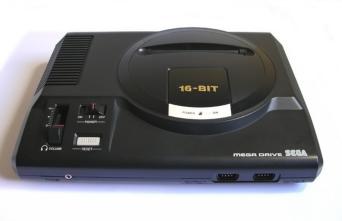 SEGA Mega Drive. Photo by Bill BertramThe Mega Drive was released in Japan in 1988 and in Europe in 1990. For the US release, in 1989, SEGA were forced to fashion a new name for the console. Due to trademark issues, the Mega Drive masqueraded under the name "Genesis" in the American territory.
SEGA Mega Drive. Photo by Bill BertramThe Mega Drive was released in Japan in 1988 and in Europe in 1990. For the US release, in 1989, SEGA were forced to fashion a new name for the console. Due to trademark issues, the Mega Drive masqueraded under the name "Genesis" in the American territory.
SEGA's campaign for mastery of the home console market initially focused on attracting older gamers to the Mega Drive. They produced games, such as Altered Beast and Phantasy Star II, which were intended to appeal to a more mature audience than Nintendo, who targeted youngsters.
Mega Drive Reception
In Japan, the Mega Drive endured a decidedly mediocre reception. It finished in third place, behind two other 16-bit consoles; Nintendo's SNES and NEC's PC Engine.
In both Europe and North America the Mega Drive's early competition came from the pervasive NES and NEC's PC Engine, which was re-branded TurboGrafix for the West. NEC's effort fell by the wayside due largely to lackluster marketing and games which didn't show off the hardware to the same extent as the Mega Drive's early games. The 8-bit NES looked dated beside the new generation of console hardware, but its healthy back catalogue of popular games helped Nintendo resist the 16-bit era for some time.
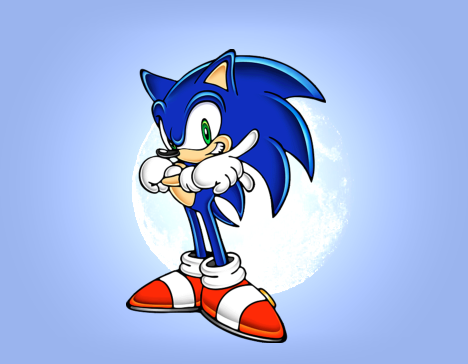
SEGA realised they needed a new mascot to go head-to-head against Nintendo's Mario. They retired Alex Kidd and created a new hero. Sonic the Hedgehog – released in 1991 – was designed to be the cooler alternative to Mario and his trademark speed was a vehicle to showcase the impressive technical capability of the Mega Drive. Sonic's unprecedented speed, rate of gameplay and quality of graphics gained him many fans and he quickly became a gaming icon.
Sonic spectacularly outclassed anything available on the NES and caused sales of the Mega Drive to boom in all territories. Sonic the Hedgehog soon replaced Altered Beast as the game which was shipped with new consoles.
Main Competition: The SNES
The Mega Drive's main competition came from Nintendo's foray into the 16-bit era. The SNES (Super Nintendo Entertainment System) was released two years after the Mega Drive. With the Mega Drive already occupying a healthy market position, the SNES faced an uphill struggle.
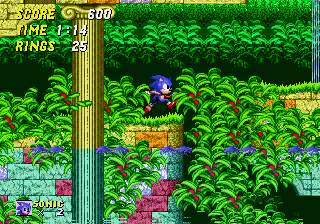 Sonic the Hedgehog 2 (Mega Drive)Nintendo sought to regain a dominant position in the market by milking the franchises they had established during the 8-bit era. With the release of new instalments of familiar series' such as Mario and Zelda, consumers flocked to Nintendo's new console. SEGA countered this by releasing Sonic the Hedgehog 2 in the midst of a media and marketing frenzy. In Europe and North America, its release date was dubbed "Sonic 2's Day". And so began the most memorable and bitterly fought console war to date.
Sonic the Hedgehog 2 (Mega Drive)Nintendo sought to regain a dominant position in the market by milking the franchises they had established during the 8-bit era. With the release of new instalments of familiar series' such as Mario and Zelda, consumers flocked to Nintendo's new console. SEGA countered this by releasing Sonic the Hedgehog 2 in the midst of a media and marketing frenzy. In Europe and North America, its release date was dubbed "Sonic 2's Day". And so began the most memorable and bitterly fought console war to date.
In terms of raw technical prowess, the SNES is generally regarded as being superior to the Mega Drive. The SNES' graphics hardware was able to scale and rotate sprites, in its much touted "MODE7", which was used to great effect in Mario Kart.
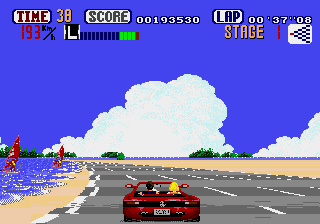 Outrun (Mega Drive)To perform the same feats, the Mega Drive had to do sprite scaling and rotation with its main processor. However, the Mega Drive had a significantly faster processor so it just about managed to pull off sprite scaling games, such as Outrun. The speed of the Mega Drive's processor meant it was capable of much faster, frenetic games such as Sonic and Gunstar Heroes. The upshot was that the SNES could output slightly higher quality graphics, while the Mega Drive could provide faster paced gameplay.
Outrun (Mega Drive)To perform the same feats, the Mega Drive had to do sprite scaling and rotation with its main processor. However, the Mega Drive had a significantly faster processor so it just about managed to pull off sprite scaling games, such as Outrun. The speed of the Mega Drive's processor meant it was capable of much faster, frenetic games such as Sonic and Gunstar Heroes. The upshot was that the SNES could output slightly higher quality graphics, while the Mega Drive could provide faster paced gameplay.
SEGA's amusingly derisive marketing campaigns attacked the SNES and placed the Mega Drive in consumers minds as the more trendy and desirable of the two consoles.
The final sales figures indicate that the SNES dominated the Japanese market, while the Mega Drive came out on top in both the European and North American territories.
Flushed with their success in the 16-bit era, SEGA tried to usher in a new era ahead of its time and crazily released two 32 bit consoles; the 32X and the Saturn. This led to confusion amongst consumers who were not keen to upgrade and marked the start of SEGA's decline as a producer of home video games consoles.
Hardware
Mega Drive
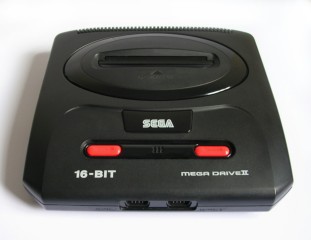 SEGA Mega Drive II.
SEGA Mega Drive II.
Photo by Bill BertramThe Mega Drive is a 16-bit video games console which loaded games supplied on cartridges. After the original launch of the Mega Drive, SEGA released the Mega Drive II, which had a square shape and was cheaper to produce. The Mega Drive II was completely compatible with the original Mega Drive, although there were a few minor differences. For instance, the Mega Drive II lacked the headphone jack present on the original console.
The Mega Drive was backwards compatible with games designed for SEGA's previous console, the Master System. Since the Mega Drive had a different shape of cartridge to the Master System, a converter was required to sit between the Mega Drive cartridge slot and the Master System game.
Two controller ports were available on the front of the console. This allowed two players to play a game simultaneously. The number of players could be increased using additional hardware, such as a multitap or J-Cart.
The Mega Drive's CPU was a Moterola 68000, which ran at just over 7.6 MHz. The console also sported a Z80 processor which was used for both Master System compatibility and for audio in many Mega Drive games. The Mega Drive had dedicated graphics hardware. Its VDP (Video Display Processor) was backwards compatible with the Master System's graphics hardware. For audio, it had two sound chips. A Yamaha YM2612 and a Texas Instruments SN76489 compatible device, which was required for Master System compatibility.
Controllers
Three Button
 3 button controller.
3 button controller.
Photo by Michael DrakeThe Mega Drive was originally sold with a three button controller. It had a round digital directional pad, a start button and three buttons; A, B and C, which were arranged in a row. The controller was a sleek black affair, with a crescent shape.
Six Button
When Street Fighter was released for the Mega Drive, SEGA released a new controller. It featured three new buttons – X, Y and Z – which were positioned under the old A, B and C buttons. The new button layout mimicked the layout used by Street Fighter on arcade machines. This made the controller excellent for fighting games. The SNES controller had four buttons on the face and two shoulder buttons, making it more clumsy for use with fighting games such as Street Fighter.
The six button Mega Drive controller was used as a basis for the Saturn's controller. Essentially the Saturn added an extra two buttons as shoulder buttons. The Saturn's controller, which still retained the distinctive crescent shape, is widely regarded as the greatest digital controller ever designed.
Multitap
Various multitaps were released, which effectively increased the number of controller ports. This allowed more players to take part in a game simultaneously.
J-Carts
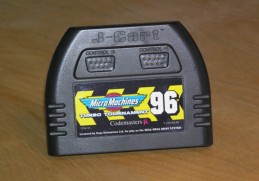 J-Cart. Photo by Michael DrakeJ-Carts were game cartridges which had two additional controller ports built in to the cartridge. With two controllers plugged into the Mega Drive and a further two occupying the additional ports on the J-Cart, it was possible to have simultaneous four player games, without the need for a multitap. Codemasters developed the J-Cart for their heavily multi-player oriented games; Micro Machines and Pete Sampras Tennis.
J-Cart. Photo by Michael DrakeJ-Carts were game cartridges which had two additional controller ports built in to the cartridge. With two controllers plugged into the Mega Drive and a further two occupying the additional ports on the J-Cart, it was possible to have simultaneous four player games, without the need for a multitap. Codemasters developed the J-Cart for their heavily multi-player oriented games; Micro Machines and Pete Sampras Tennis.
Mega-CD
The Mega-CD was a Mega Drive add-on which ran games supplied on CD, rather than cartridge. The Mega-CD had its own central processor, graphics hardware and sound hardware. It needed the Mega Drive for the controller ports and TV outputs. The Mega-CD is generally viewed as a failure. It sold extremely poorly in Europe due to being excessively priced.
In spite of this, the Mega-CD did have a few brilliant games. Sonic CD, the only Sonic game to be released for the console, is often cited by fans as being the best Sonic game ever. It was a huge game involving time travel and alternate futures. It also had hand drawn animated cutscenes, which weren't possible on the more space-limited cartridge media of the Mega Drive or SNES.
32X
The 32X was another add-on for the Mega Drive. This one was a 32-bit console. The Mega Drive was used for power, its controller ports and TV outputs. The console attracted a lot of interest and millions of units were ordered. Sadly, due to production problems only thousands were produced.
The 32X was developed by SEGA of America and was released in North America in the same month as SEGA of Japan released the SEGA Saturn in Japan. SEGA's two 32-bit consoles caused confusion amongst consumers. People were reluctant to buy the 32X, seeing the Saturn as the true 32-bit console. The Saturn was more powerful and had the support of Japanese third party games developers behind it.
Neither the 32X of the Saturn can be seen as successes. Their poor sales were the beginning of the end for SEGA, as a producer of video games consoles.
